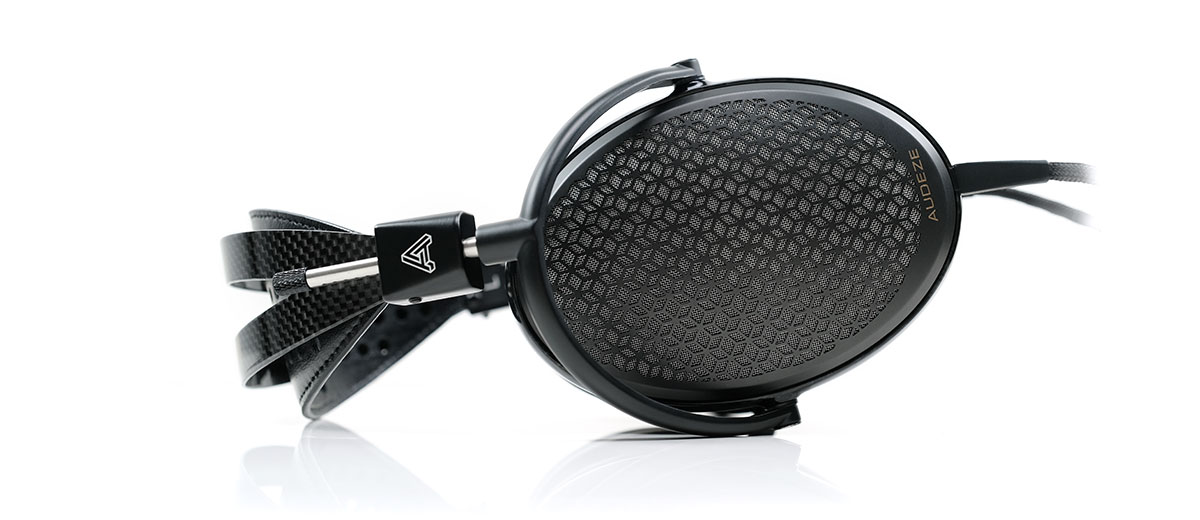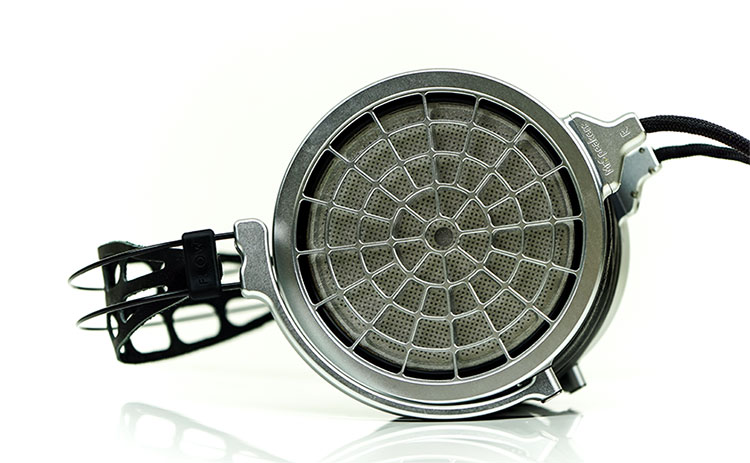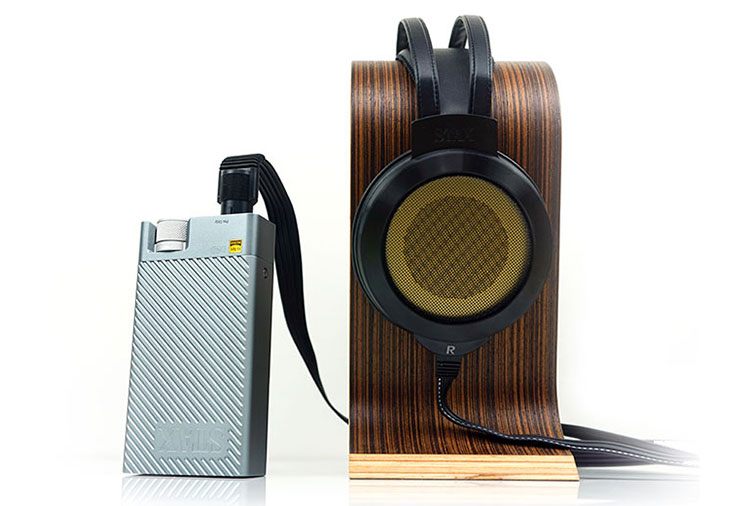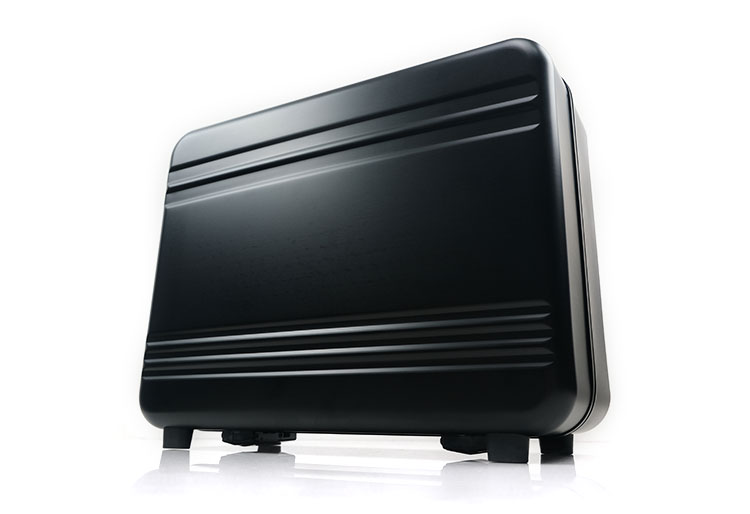Select Comparisons
HIFIMAN Shangri-La Jnr
In the realm of affordability, the Shangri-La Jr is HIFIMAN’s flagship electrostatic headphone with a slightly lower price compared to the CRBN. Yup, there is the Shangri-La at $53k but it’s a rarefied purchase for a select few who can afford it.
$4000
Technical
Both the CRBN and the Shangri-La Jr are Pro Bias-compatible electrostatic headphones with 5-pin connectors. The only nuanced difference is the Jr being purpose-built to partner with an accompanying tube-based Pro Bias amplifier making it often a system choice though you can still buy it on its own. The CRBN is solo, as in no system amplifier partner.
Both headphones have a strong diaphragm focus but very different pitches. There is no official mention of the Jr diaphragm driver size but it is more spherical compared to the ovoid design of the CRBN.
However, slim is a big push for HIFIMAN in all their diaphragm designs meaning the Jr has a nanoparticle coating on a very thin ‘nanotech’ diaphragm at just 0.001m in diameter. Audeze is not as precise in the thickness measurement for their driver simply stating it as ultra-thin but commentary has them around 1.5 to 2.2 microns,(0.0011mm to 0.0022mm), thick.
I would presume however the Jr diaphragm has that resistive coating element which would be the big differentiator from the CRBN. The Audeze version uses carbon nanotubes directly suspended inside the diaphragm material and has no resistive coating.
One thing to note is the tuning goal from both companies and how it has seeped into the implementation of these two drivers. HIFIMAN seems to be going for speed, articulation, and detail and thus a traditionally taut diaphragm with a lot more tension. That’s been a goal in most of the HIFIMAN creations, especially the high-end planars.
Audeze, on the other hand, wanted to tease out a better bass response as one of their primary goals. That means less tension on the CRBN diaphragm and more space for it to move to create a better bass response.
Design
The Jr design is probably the ideal HIFIMAN design iteration for comfort with its spin-off from the Susvara design. I tend to gravitate to this shape rather than some of the newer single headband variations they came out with recently.
It does look quite different from the CRBN but despite being the smaller form factor it is 74g heavier officially. That being said, the comfort levels of both are excellent. The Jr might be a shade more balanced for pressure due to the smaller dimensions but the CRBN soft lateral clamp and softer pads produce a similar comfortable feeling.
Quality of finish? Well, the Jr is very good, but the CRBN is excellent with an edge on the materials being used. For example, leather versus protein leather, carbon fiber versus spring steel, and some slight creaking versus a very smooth articulation on the pivot blocks.
The final point is the cable quality with the Jr losing out here using the same design and materials as the lower-class Jade II. It is light, and easy to manage but a bit flimsier compared to the CRBN cloth jacketed and sturdy-looking version. Both are terminated with good quality pro-bias 5-pin connectors with excellent strain relief so no issues there.
Performance
The differences between these crudely boil down to timbral preferences and as a knock-on effect in some cases the level of perceived detail. I find both headphones equally appealing but these differences make them complementary to me rather than competing for the same space.
The timbral preference goes to the CRBN with its smoother more natural Harman target-friendly response curve, warmer and fuller bass response, and some gorgeous rich vocal performances. Staging is deep, slightly mid-forward, and more on the relaxed side for the highs compared to the Jr.
The response curve here is more in tune with what Audeze is trying to achieve with their current headphone tuning with good head gain for vocal clarity and less excess treble energy to keep the harmonic balance more to the even side making for a very listenable presentation.
The Shangri-La Jr, on the other hand, has the lighter bass touch, and a bit more timbral contrast from a stronger treble elevation post 5kHz so it sounds a bit cooler or more neutral in coloration. Vocal positioning is also a bit more relaxed across 1-3k but still very clear sounding which is consistent with how HIFIMAN tunes some of their planar headphones.
I guess you could say the Jr has that classic electrostatic approach to speed and detail also with a low-end extension that is excellent but comparatively more linear compared to the CRBN’s stronger weight and warmth.
The Jr’s higher level of tonal contrast does bias your listening more to the upper mids and highs staging-wise so they generate a bit more perceived sparkle and bite. This in turn creates a performance where information, notes, and spatial detail have a bit more shimmer, chiseled if you will, making them easier to pick out.
Dan Clark Audio VOCE
The VOCE was launched in 2018 and is the first electrostatic product launched by DCA as well as their flagship headphones. You can find our full review here.
$2999
Technical
Both headphones use fairly large Pro Bias compatible electrostatic drivers with the circular VOCE dust-sealed version measuring in at 88mm and the ovoid CRBN diaphragm at 90mm.
I also have to presume the VOCE uses a resistive coating for holding the charge whereas the carbon nanotubes inserted directly into the material of the CRBN diaphragm control and shape the required resistance level.
Whilst it is not explicitly stated in the exact diaphragm construction there is a nod to pitching for a bit more bass from the VOCE than is the norm. I would have to assume that DCA also didn’t go for a super tight or high-tension construction in the same manner as Audeze had in mind with the CRBN driver.
Both headphone stator builds do get some unique treatment but it’s a little less clear how exactly VOCE’s stator design has been done, as it simply says advanced and that it is insulated.
We do know that DCA states that the charged driver will possibly touch the stator during movement hence the stator insulation. That isn’t unusual except that we also know that Audeze took steps to avoid this with their diaphragm movement via the carbon nanotube’s improved charge retention and the enhanced spacing to the stator.
Design
I think both designs are pretty much up there as best in class but they are very different in both form factor and aesthetics.
The VOCE has that distinctive spider’s web grill and classic circular aluminum cup ring with very thick and supple Italian Nappa leather pads.
These pads mitigate any potential discomfort from their stronger lateral clamping and narrow surface contact points on the pads themselves. The VOCE vertical pressure is zilch with the super-lightweight nitinol arching rods and leather perforated strap.
The VOCE is also lighter by 30g compared to the CRBN though this additional weight is rarely felt. It is the discreet form factor of the VOCE that is the most pleasing aspect of the design. The CRBN just feels like the bigger headphone on your head in comparison whereas the VOCE never catches the edge of your vision.
The CRBN is the comfier though for longer listening sessions. The larger ovoid cup design has some potential to pull down but the lateral clamping pressure is just enough to prevent it from doing that quite nicely. The leather pads are equally as supple but benefit from a slightly wider contact surface that gives it that supremely comfortable feel, even after a few hours of use.
Both have Pro Bias 5-pin terminations on their jacketed cables with the VOCE’s VIVO cable the heavier and bigger of the two overall. One thing to note, you can swap out the VOCE cable via a screw and socket system but only to change to a new VOCE cable via DCA. Still, a bit more flexible than the CRBN non-replaceable cable
Performance
Both the VOCE and CRBN are aiming for a more natural sound and less of the classic electrostatic high contrast tone. Neither is going to sound sharp or very treble-peaking off a solid tube e-stats amp that’s for sure. However, there is some different imaging emphasis going on between these two contenders.
The CRBN is a little more weighted and denser sounding on the low-end but the gap and overall coloration are not as stark between them as was the case with the Jr.
The VOCE retains some nice warmth but not quite the same forwardness, perhaps a little more linear on the low-end in comparison. It also bumps on the lower mids a little similar to the CRBN which injects some nice presence and a bit of warmth into instrumental timbre.
The VOCE exhibits more tonal contrast in the mids because of the stronger treble presence from 5k onwards. There is some dipping around 6-7k and 9-10k but otherwise, the VOCE general energy levels are higher compared to the CRBN’s more natural Harman curve style fade.
Mids on the VOCE are more scooped out from 1-4k which pushes vocals presence back a bit with what seems to be an impressively wide left-right stereo image for supporting instruments.
The vocals imaging though can sit behind energetic lower mids instrumentals reducing their impact. For example, Birdy’s “Skinny Love” piano accompaniment was imaging ahead of her vocal which reduced the clarity just a little despite a more accurate harmonic balance.
It’s a contrast to the more forward 1-4k head gain curve of the CRBN where vocals are more rounded, smoother, and intimate. However, they can also sound clearer compared to the VOCE, with instrumental imaging more naturally ‘tucked in’.
Stax SR-007MK2
This is my purchase from about 3 years ago. Due to its richer low-end tonal quality, it is quite different from alternative electrostatic headphones out there. I was never a fan of the SR-009s energetic highs by the way.
$2600
Technical
The priority design goals in terms of tuning response for both seem to be quite similar and that is to get around the traditional anemic bass response from electrostatic headphones. However, the driver engineering inside these two headphones contrasts a fair bit physically.
Purely on size level, we do not have an exact measurement of the 007 MK2 driver but this is more of a classic circular design as opposed to the ovoid form factor of the CRBN. Also, the 007 MK2 uses a solid stator implementation with no holes to increase the diaphragm vibration area to achieve its renowned additional rich bass response.
Audeze takes a very different approach with the low-inertia CRBN driver. The stator gaps or holes remain and instead, the resistive coating is removed with carbon nanotubes directly suspended in the diaphragm material that produces an improved charging retention method for better efficiency.
This allows a slight decrease in the diaphragm tension which, combined with increased space to the stator itself, allows the CRBN’s diaphragm a stronger excursion level without touching the stator.
This improved excursion, in conjunction with the new damping material and a high dielectric strength perforated stator design, allows Audeze to improve the bass response from the CRBN without loss of high-end detail.
Design
I can’t fault either design and always felt Stax’s flagship stuff to be incredibly well-engineered. The key difference is really in the nuanced articulating aspects between the MK2 and the CRBN and the general form factor in terms of looks and the fitting experience.
The 007 MK2 has that classic circular form factor which only it, the 009 version, and the new SR-X9000 use. The CRBN’s ovoid or longer cup design and more flamboyant carbon fiber arch design make it the taller or bigger of the two headphones.
And yet, the CRBN is lighter at 300g compared to 365g. I suspect much of the additional weight of the Stax headphones comes from using a solid metal enclosure as opposed to the polymer acetate used for the CRBN rings.
Also, despite the CRBN headband being the physically bigger of the two, it is likely the leather-enclosed headband arch inside the 007 MKII is a heavier spring steel design.
Comfort
I really cannot separate the comfort levels of these two headphones, they are that good. The CRBN does feel the bigger of the two on my head cue to those large cups and leather earpads with a slightly stronger side clamp.
The 007 MK2 is a little more vertical pressure-sensitive for larger heads though the effect is extremely mild with the self-adjusting pressure strap doing an excellent job of mitigating any potential scalp hotspots.
The pads on both are equally supple with the 007 MK2 pads the slightly deeper of the two but with a smaller inner cavity. The cavity though is not a perfect oval with more backspace to fit your ear so unless you have very large ears it is unlikely the walls of the pads will touch your ears.
The 007 MK2 does not have the same level of lateral cup articulation as the CRBN but it does have a unique rotating cup platform that allows you to fine-tune the pad positioning over your ear.
Performance
Probably the two electrostatic headphones out there with the strongest bass response out there. The 007 MK2 is probably the more elevated of the two and the more dominant, aided by a midrange that is not as forward in terms of presence and imaging compared to the CRBN.
I would also say the CRBN has an edge in absolute extension whereas the MK2 is punchier with a more pronounced lift from 70Hz right the way up to 1k.
The CRBN low-end is not neutral for sure but the curve is more linear, with less of a pronounced shelf in the mid to upper bass, and a rise into the mids rather than a drop post-1k. It is a healthy beefy low-end sound with some nice warmth but not as in your face as the MK2 beefy tuning.
The mids is a different matter. The CRBN sounds a lot clearer and more natural-sounding to my ear with better vocal presence from that lifted 1-4k head gain tuning. This is an excellent electrostatic headphone for hard rock if you want to retain male vocal clarity.
In comparison, the 007 MK2 mids are more recessed and a little compressed sounding, especially with rock male vocals that struggle to compete with planted and energetic lower mids. The MK2 tends to do much better with modern R’n’B or synthwave mixes which space out the mids a bit more a more muted lower-mids instrumentation.
The treble on both is quite relaxed, however, the fade on the CRBN is a few dB higher so tends to sound a little airier. The MK2 does have a little 8-10k lift but it results in the upper mids harmonic offering a metallic unnatural tone to Tambourine timbre whereas the CRBN timbre is consistently smoother.
Our Verdict
The Audeze CRBN is a sublime and gorgeous-sounding electrostatic headphone but also one that does not play by the electrostatic norms. A few e-stat cans have tried and failed before to get that bass rumbling and remain a coherent listening experience, the CRBN is not one of those failures, not by a long shot, it sounds powerful yet very coherent at the same time.
Its distinct and dense natural tonal qualities will also provide a very nice contrast to the likes of the cleaner airier-sounding Shangri-La Jr which is exemplary in terms of micro-detail. I would say if you had these two side-by-side then have a very complementary high-end 1-2 for a wide range of genres.
It is just as well that CRBN is a well-made and very comfortable headphone to wear because it is quite an easy listening experience and one that will have you trawling through your music content for many an enjoyable hour.
Audeze CRBN Electrostatic Headphones Specifications
- Transducer type: Push-pull electrostatic
- Functional bias voltage: 580 VDC Stax Pro Bias
- Electrostatic Capacitance: 100 pF (including cable)
- Diaphragm type: Ultra-thin custom carbon nanotube
- Transducer size: 120mm x 90mm
- Frequency response: 20Hz – 40kHz
- Maximum SPL: >120dB
- THD: <0.1% @ 90dB
- Attached cable: 2.5m OCC monocrystal copper, 5-pin Pro Bias
- Housing: Magnesium, stainless steel, and polymer acetate
- Earpad material: Premium leather
- Headband: Carbon fiber and premium leather
- Weight: 300g






